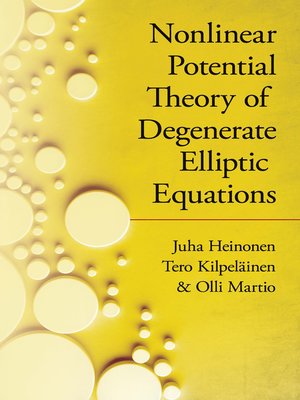Nonlinear Potential Theory of Degenerate Elliptic Equations
ebook ∣ Dover Books on Mathematics
By Juha Heinonen

Sign up to save your library
With an OverDrive account, you can save your favorite libraries for at-a-glance information about availability. Find out more about OverDrive accounts.
Find this title in Libby, the library reading app by OverDrive.



Search for a digital library with this title
Title found at these libraries:
| Library Name | Distance |
|---|---|
| Loading... |
A self-contained treatment appropriate for advanced undergraduate and graduate students, this volume offers a detailed development of the necessary background for its survey of the nonlinear potential theory of superharmonic functions. Starting with the theory of weighted Sobolev spaces, the text advances to the theory of weighted variational capacity. Succeeding chapters investigate solutions and supersolutions of equations, with emphasis on refined Sobolev spaces, variational integrals, and harmonic functions. Chapter 7 defines superharmonic functions via the comparison principle, and chapters 8 through 14 form the core of the nonlinear potential theory of superharmonic functions. Topics include balayage; Perron's method, barriers, and resolutivity; polar sets; harmonic measure; fine topology; harmonic morphisms; and quasiregular mappings. The book concludes with explorations of axiomatic nonlinear potential theory and helpful appendixes.







